Taxonomy of commonly fossilised invertebrates

Although the phylogenetic classification of non-vertebrate animals (both extinct and extant) remains a work-in-progress, the following taxonomy attempts to be useful by combining both traditional (old) and new (21st-century) paleozoological terminology.
The paleobiologic systematics which follows is not intended to be all-inclusive or completely comprehensive. For practical reasons and relevancy, the below classification and annotations emphasize invertebrates that (a) are popularly collected as fossils and/or (b) no longer continue alive on this planet. Therefore, as a result, some phyla, classes, and orders of invertebrates are not listed.[1]
If a non-vertebrate animal is mentioned below using its common, or vernacular name, the creature is usually a living, present-day invertebrate. But if a non-vertebrate is cited below by its scientific, taxonomic genus (in italics), then it is typically an extinct invertebrate, known only from the fossil record.[2]
Invertebrate clades that are (a) very important as fossils (for example, ostracods frequently used as index fossils), and/or (b) very abundant as fossils (for example, crinoids easily found in crinoidal limestone),[3] are highlighted with a bracketed exclamation mark [ ! ].
Invertebrate groups that (a) are now substantially extinct, and/or (b) contain a large proportion of extinct species, are followed by a dashed notation [ – such as this ]. But invertebrate clades which are now completely extinct are designated with a bracketed dagger [ † ]:
Domain of Eukaryota / Eukarya

(eukaryotes / eukaryans / all cellular organisms bearing a central, organized nucleus with DNA)
- comprises most of the species of life which have been documented by biologists and paleontologists as either living or deceased
- includes a wide variety of single-celled protists, all algae, most plankton, most molds, the green plants, and all animal-related kingdoms
Sub-domain of Opisthokonta
(opisthokonts / the animal-related kingdoms / the proto-spongal choanoflagellates, proto-fungal microsporidians, true fungi, and true animals
- comprises most life forms documented as either living or deceased
- excludes many molds, all one-celled protists (or protoctists), all algae, and all green plants
Kingdom of Animalia / Metazoa --- All Invertebrates and Vertebrates
(metazoans / many-celled true animals / multi-cellular creatures that grab and ingest their organic food)
- comprises most living and deceased species which have ever been recorded by paleontological and life scientists
- excludes all unicellular and fungal opisthokonts
Sub-kingdom of Parazoa
(parazoans / typically sessile, basal non-eumetazoans / the most-primitive animals / the simplest, colonial, attached, bottom-dwelling, marine invertebrates)
Phylum Archaeocyatha / Archeocyatha / Archaeocyathida / Archeocyathida / Pleospongia [†]
(cone-shaped archaeocyathids/archeocyathids / cup-shaped archaeocyathans/archeocyathans / reef-building pleosponges / calcareous "ancient-cups")
(includes fossil genera such Archaeocyathus, Cambrocyathus, Atikonia, Tumuliolynthus, Kotuyicyathus, Metaldetes, Ajacicyathus and Paranacyathus)
(Archaeocyatha is sometimes classified as a class of Porifera below)
Phylum Porifera / Nuda / Spongia
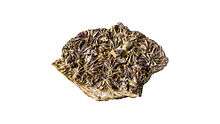
(quintessential true sponges / marine, colonial, pore-bearing animals / organized collar-flagellates / poriferans; today mostly siliceous) – half of all documented species of Porifera are fossils and extinct [4]
(Porifera may eventually be broken up into separate phyla)
- Sub-phylum Calcarea / Calcispongiae (primitive calcareous poriferans such as yellow lemon sponge, sphinctozoans, pharetronids, Scypha, Leucetta, Gravestockia, Grantia, Astraeospongium, Clathrina, Lelapia, Rhaphidonema, and Girtyocoelia)
- Class Calcinea
- Class Calcaronea
- Class Stromatoporoidea / Stromatoporata / Stromatoporida / Spongliomorphida [†] (lime-layered stromatoporoids / reef-building stromatoporates / button-shaped stromatoporids / disc-shaped spongliomorphids; e.g., Stromatopora, Aulacera, Stromatactis, Actinostroma, Discophyllum, Parallelopora and Amphipora)
- Class Heteractinida [†] (Paleozoic calcitic heteractinids such as Eiffelia)
- Sub-phylum Silicea / Silicospongia (siliceous poriferans)
- Class Demospongea / Demospongiae (most living sponges hardened by opaline silica or spongin; for instance, horny sponge, bath sponge, stove-pipe sponge, yellow boring sponge, carnivorous sponge, bristle sponge, chaetids, lithistids, Astroclera, Ceractinomorpha, Clionoides, Hindia, Ventriculites, Laosoiadia, Clionolithes, Tetractinella, and Astylospongia)
- Class Hexactinellida / Hyalospongiae / Sclerospongiae (siliceous, deep-sea glass sponges, e.g. glassy-latticed Venus flower basket, bird's nest sponge, cloud sponge, Hexactinella, Hydroceras, Dictyonina, Brachiospongia, Titusvillea, and Rhizopoterion)
Sub-kingdom of Eumetazoa
(eumetazoans / true metazoans / typically mobile, multicellular animals)
(Eumetazoa contains most of the living and deceased species of recorded life, including most invertebrates (alive and extinct), as well as all vertebrate animals)
Super-phylum of Radiata
(radiates / non-bilaterian eumetazoans)
Phylum Cnidaria / Coelenterata
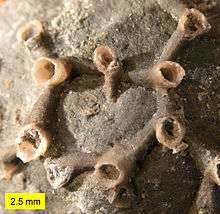
- Class Hydrozoa (hydra or hydroid group)
- Subclass Stromatoporoidea [†] (lime-layered stromatoporoids)
- Subclass Conulata [†] (four-sided, pyramidal conularians)
- Class Anthozoa (corals / polyps)
- Subclass Octocorallia / Alcyonaria (soft corals and sea pens)
- Subclass Zoantharia [!] (sea anemones and most extant corals)
- Order Rugosa / Tetracoralla [†] [!] (wrinkled, horn-shaped tetracorals such as Petoskey coral, Caninia and Heliophyllum)
- Order Tabulata / Schizocoralla [†] [!] (tabulate corals, for instance, Favosites and Aulopora)
- Order Scleractinia / Hexacoralla [!] (stony corals such as brain coral, Favia, Meandrina, and most living corals)
Super-phylum of Lophotrochozoa / Protostomia # 1
(lophotrochozoan bilaterians, such as flatworms, ribbon worms, lophophorates, and molluscs)
Phylum Bryozoa / Ectoprocta / Polyzoa
(bryozoans / moss animals) – half of all documented species of Bryozoa are fossils and extinct [5]
- Class Stenolaemata / Gymnolaemata [!] (mostly marine, calcareous bryozoans)
- Order Cheilostomata [!] (living, rimmed-mouthed moss animals)
- Order Cyclostomatida (uncontracted, round-mouthed bryozoans including fossil Stomatopora)
- Order Cystoporata [†] (extinct, minor group of moss animals)
- Order Trepostomata [†] [!] (changed-mouthed bryozoans such as extinct Constellaria and Monticulipora)
- Order Cryptostomata [†] [!] (round hidden-mouthed bryozoans such as Archimedes, Fenestrellina and Rhombopora)
- Order Ctenostomata [†] (uncommon, comb-mouthed bryozoans)
- Order Phylactolaemata (living, fresh-water bryozoans)
Phylum Brachiopoda
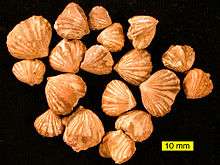
(lampshells, brachiopods or "brachs," not to be confused with the hard-shelled marine mollusks below) – 99 percent of all documented species of Brachiopoda are now extinct
- Subphylum Linguliformea (inarticulate atremates, such as "living fossil" Lingula) – but mostly extinct
- Subphylum Craniiformea (inarticulate neotremates, such as extant Crania) – but mostly extinct
- Subphylum Rhynchonelliformea [!] (articulate brachiopods with hinged valves; includes most extinct and living brachs)
- Class Rhynchonellata [!]
- Order Orthida [†] [!] (orthid brachs such as fossil Orthis)
- Order Pentamerida [†] (pentamerid brachs such as Conchidium)
- Order Rhynchonellida [!] (rhynchonellid brachs such as fossils Rhynchotrema and Rhynchonella)
- Order Spiriferida [†] [!] (spiriferid brachs)
- Suborder Spiriferinida [†] [!] (spiriferid brachs such as Spirifer and Eospirifer)
- Suborder Atrypida [†] [!] (atrypid brachs such as Atrypa)
- Order Terebratulida [!] (most living brachiopods; includes fossil Dielasma)
- Class Strophomenata [†] [!] (so-called petrified butterflies)
- Order Strophomenida [†] [!] (strophomenid brachs)
- Order Productida [†] [!] (spiny or productid brachs)
- Suborder Chonetidina [†] [!]
- Suborder Productidina [†] [!]
- Class Rhynchonellata [!]
Phylum Annelida
(segmented worms such as earthworms and leeches)
- Class Polychaeta (marine annelids / polychaetes)
- Order Scolecodonta [!] (mostly chitinous jaws of scolecodonts)
Phylum Mollusca
(molluscs or mollusks, not to be confused with the hard-shelled marine brachiopods above)
- Class Monoplacophora (extinct, except for "living fossil" Neopilina)
- Class Bivalvia / Pelecypoda (bivalves / pelecypods) – half of all documented species of Bivalvia are fossils and extinct [6]
- Subclass Lamellibranchia [!] (clams, oysters, mussels and scallops)
- Class Gastropoda (gastropods / snail group)
- Subclass Prosobranchia (marine snails and conches)
- Subclass Opisthobranchia (sea slugs)
- Subclass Pulmonata (land snails)
- Class Cephalopoda (cephalopods) – 97 percent of all documented species of Cephalopoda are now extinct
- Subclass Nautiloidea (mostly extinct, but includes "living fossil" Nautilus)
- Order Orthocerida [†] [!] (long, straight-shelled nautiloids)
- Subclass Ammonoidea [†] [!] (generally coiled-shelled ammonoids)
- Agoniatitic (agoniatites) [†]
- Goniatitic (goniatites) [†] [!] (ammonoids with simple sutures)
- Ceratitic (ceratites) [†]
- Ammonitic [†] [!] (the true ammonites, bearing complex sutures)
- Subclass Coleoidea (includes the living squid, cuttlefish, and octopus)
- Order Belemnoidea [†] (extinct orthoconic belemnoids)
- Subclass Nautiloidea (mostly extinct, but includes "living fossil" Nautilus)
Super-phylum of Ecdysozoa / Protostomia # 2
(ecdysozoans, such as nematodes, horsehair worms, and molting bilaterians / panarthropods))
Phylum Tardigrada
(panarthropodic water bears)
Phylum Onychophora
(panarthropodic velvet worms, including proto-arthropodic fossils of Arthropleura and Aysheaia)
Phylum Arthropoda
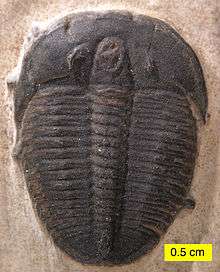
(arthropods; jointed legged creatures with an exoskeleton)
- Subphylum Crustacea (crustaceans)
- Class Ostracoda (ostracods)
- Class Malacostraca (true crabs, lobster and most shrimp)
- Class Branchiopoda (brine shrimp)
- Order Notostraca
- Class Cirripedia (barnacles)
- Class Arachnoidea
- Subphylum Trilobitomorpha [†] (extinct trilobite group)
- Class Trilobita [†] (the armored trilobites)
- Subphylum Hexapoda
- Subphylum Chelicerata
- Class Arachnida (spiders, best preserved in amber)
- Class Merostomata ("living fossil" horseshoe crab and extinct eurypterid)
- Subphylum Myriapoda
Super-phylum of Deuterostomia / Enterocoelomata
(second-mouthed bilaterians called deuterostomians, such as chordates and echinoderms)
Phylum Echinodermata
(echinoderms) – 72 percent of all documented species of Echinodermata are fossils and extinct [7]
- Subphylum Crinozoa (sessile echinoderms) – 91 percent of all documented species of Crinozoa are now extinct
- Class Crinoidea (crinoids / sea lilies) – See Crinozoa above
- Subphylum Blastozoa [†] (extinct blastoids)
- Class Diploporita
- Class Rhombifera
- Subphylum Echinozoa (mobile echinoderms) – 89 percent of all documented species of Echinozoa are now extinct
- Class Echinoidea (echinoids or sea urchins) – See Echinozoa above
- Subphylum Asterozoa
- Class Asteroidea (sea stars / starfish)
- Class Ophiuroidea
Phylum Hemichordata

(hemichordates such as extant acorn worms) – Less than half of the documented species of Hemichordata are fossils and extinct
- Class Graptoloidea [†] (extinct graptolites)
- Order Dendroidea [†]
- Order Graptoloidea [†]
- Suborder Didymograptina [†]
- Suborder Diplograptina [†]
- Suborder Monograptina [†]
Phylum Chordata
(both invertebrate and vertebrate chordates; animals possessing a notochord)
Invertebrate subphyla
- Subphylum Urochordata (invertebrate tunicate such as sea squirts)
- Subphylum Cephalochordata (invertebrate lancelets)
Subphylum Vertebrata
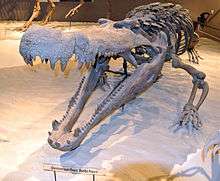
- Vertebrates such as hagfishes, lampreys, conodonts [†], ostracoderms [†], placoderms [†], sharks, ray-finned fishes, lobe-finned fishes, amphibians, reptiles, dinosaurs [†], birds and mammals.
References
- ↑ For superb anatomical illustrations and much-more comprehensive information, see Volume E (Archaeocyatha / Porifera) through Volume V (Graptolithina), published 1953 to 2006 (and continuing), of the Treatise on Invertebrate Paleontology, long-edited by Raymond C. Moore and Roger L. Kaesler (Boulder, Colorado: Geological Society of America; and Lawrence, Kansas: University of Kansas Press). But be warned that some terms therein employed – such as supersubphylum – can be unnecessarily wordy or abstruse. Incidentally, revised volumes have been recently published regarding the sponges/archaeocyatha (2004, ISBN 0-8137-3131-3) and the brachiopods (2006, ISBN 0-8137-3135-6).
- ↑ The names of genera, orders, classes and phyla have been culled from dozens of sources, both current and decades-old. See the International Code of Zoological Nomenclature (ICZN), as well as Volume 1 and Volume 2 of Grzimek's Animal Life Encyclopedia (Farmington Hills, Michigan: Gale Group), edited by zoologists Michael Hutchin, Dennis A. Thorney and Sean F. Craig (2003).
- ↑ For correspondingly ancient ecosystems, see the Treatise on Ecology and Paleoecology, Volume 2: Paleoecology, edited for years by Harry S. Ladd (1957 / 1971), and published by both the Geological Society of America (Boulder, Colorado) and the Waverly Press (Washington, D.C.).
- ↑ The rates of extinction for sponges and other phyla are derived from W. H. Easton, 1960, Invertebrate Paleontology (New York: Harper and Brothers) and various modern sources.
- ↑ For bryozoans and brachiopods, the same footnote as above.
- ↑ For bivalves and cephalopods (both mollusks), see the above notation.
- ↑ For the echinoderms, see the above footnote regarding W. E. Easton, 1960, Invertebrate Paleontology, and other sources.